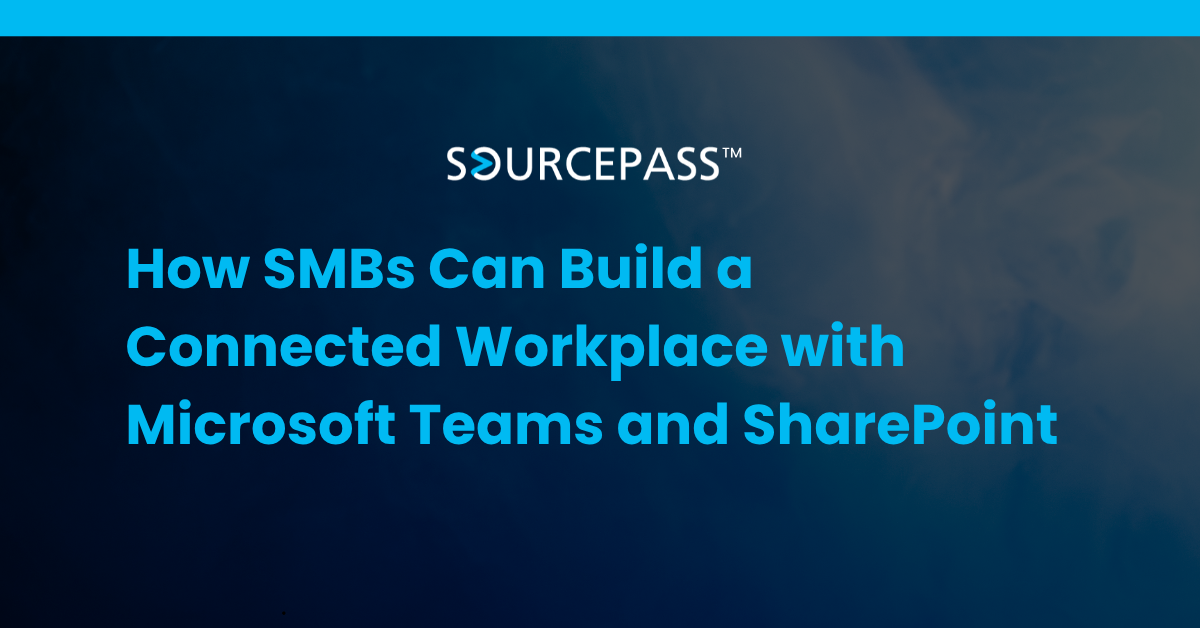How SMBs Can Build a Connected Workplace with Microsoft Teams and SharePoint
Oct 15, 2025 Alex Davis Modern Workforce & Productivity | Microsoft Solutions 3 min read



Small and midsized businesses need more than just tools—they need a connected ecosystem that helps teams communicate, collaborate, and share information securely. Microsoft Teams and SharePoint form the foundation of that connected workplace, integrating communication, file sharing, scheduling, and knowledge management in one seamless environment.
This guide explores how SMBs can use Microsoft Teams and SharePoint, along with related Microsoft 365 apps, to build a connected workplace that drives productivity, engagement, and growth.
The Foundation of Connection: Microsoft Teams and SharePoint
Microsoft Teams: Communication and Collaboration Hub
Microsoft Teams brings people, conversations, and work together in one place. Teams combines chat, video meetings, file sharing, and integrated apps to simplify collaboration and reduce the friction of switching between platforms.
For SMBs, Teams creates an organized workspace where employees can connect instantly, share project updates, and collaborate on documents in real time. Integrations with apps like Planner, OneNote, and Loop allow teams to move from discussion to action quickly.
Key benefits:
-
Real-time chat, calls, and video meetings
-
Integrated file sharing and editing with OneDrive and SharePoint
-
Customizable channels for projects or departments
-
Secure external collaboration with clients and partners
SharePoint: Organizing Knowledge and Content
SharePoint acts as the backbone of Microsoft 365’s content management and document collaboration. It provides secure storage, version control, and customizable team sites that connect employees to important content, processes, and company updates.
For SMBs, SharePoint ensures employees can easily find and share the right information without relying on email attachments or outdated file servers.
Key benefits:
-
Centralized document libraries with permission controls
-
Team sites that promote transparency and communication
-
Integration with Microsoft Search to find files, people, or projects
-
Automated workflows that reduce manual work
Integrated Apps That Strengthen Connection
Microsoft Teams and SharePoint are most powerful when paired with other Microsoft 365 tools that support communication, scheduling, and employee engagement.
Outlook and Exchange: Unified Email and Calendar
Access your email, files, and calendar all in one place with Outlook, and use Exchange to manage professional, custom business email (name@yourbusiness.com). This keeps communication streamlined and secure.
Bookings and Shifts: Smarter Scheduling
-
Microsoft Bookings helps SMBs simplify appointment scheduling with customers and partners.
-
Microsoft Shifts replaces outdated scheduling tools, helping managers coordinate employee shifts and time tracking in one view.
Viva Connections, Engage, and Learning: Employee Experience Tools
-
Viva Connections creates a central hub for company news, policies, and resources.
-
Viva Engage builds community and connection through digital conversations.
-
Viva Learning helps employees grow by surfacing internal and external learning opportunities directly within Teams.
OneDrive and Microsoft Search: Seamless Information Access
-
OneDrive ensures employees can store, sync, and share documents securely from any device.
-
Microsoft Search helps everyone quickly find what they need—files, sites, or people—across Teams, SharePoint, and Outlook.
Creating a Truly Connected SMB Workplace
Building a connected workplace with Microsoft 365 is about more than just technology—it’s about how your people work together. Here are practical steps SMBs can take to get started:
-
Centralize communication in Teams. Move project discussions, file sharing, and updates out of email threads and into dedicated Teams channels.
-
Create team sites in SharePoint. Organize documents, policies, and procedures for easy access and collaboration.
-
Automate workflows. Use Power Automate with Teams and SharePoint to reduce repetitive tasks like approvals or notifications.
-
Encourage employee engagement. Integrate Viva apps to strengthen culture, learning, and communication.
-
Train employees for success. Provide basic Microsoft 365 training to ensure consistent use across the organization.
FAQ: Microsoft Teams and SharePoint for SMB Collaboration
What is the main difference between Teams and SharePoint?
Microsoft Teams focuses on real-time communication and collaboration, while SharePoint is designed for content management and document organization. Together, they provide a complete collaboration ecosystem.
Can SMBs use SharePoint without Teams?
Yes, but Teams and SharePoint work best together. When you share a file in Teams, it is stored in SharePoint automatically, ensuring secure access and version control.
How secure are Teams and SharePoint for SMB use?
Both platforms include enterprise-grade security, including encryption, multifactor authentication, and compliance features. Microsoft 365 Business Premium adds advanced threat protection and data loss prevention for regulated industries.
Can external partners or clients access Teams or SharePoint?
Yes. Both tools allow secure external access, so SMBs can collaborate with clients, contractors, or vendors without compromising security.
How can Sourcepass help SMBs get the most from Microsoft 365?
Sourcepass helps SMBs design, deploy, and optimize Microsoft 365 environments. From Teams integration and SharePoint setup to automation and security, we ensure your collaboration tools align with your business goals.
Subscribe To
Sourcepass Insights
Sourcepass Insights
Stay in the loop and never miss out on the latest updates by subscribing to our newsletter today!
.png?width=500&height=100&name=White%20Logo%20-%20Transparent%20Tag%20(3).png)



